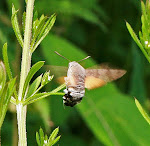In north-west England, small lakes and pools in sheltered areas such as those at Leighton Moss, Hawes Water, Foulshaw Moss and Roudsea can be rich in dragonflies during the summer months. Very difficult to photograph in flight, they are much easier at rest if carefully approached. A few commoner ones are shown here.
Common Darter (Sympetrum striolatum): Very frequent as its English name implies. It often perches on vegetation, also sometimes on the ground or board walks (as the male below). A mid-late summer flier, often seen until until November.
Photos (below): Haweswater (male red), Roudsea (female, brown)
.jpg)
.jpg)
Black Darter (Sympetrum danae): A frequent percher on vegetation and man-made structures such as gates, fence posts, etc. Flies July-September.
Photos (below): Foulshaw Moss, male (black) and female.
.jpg)
+30.8.08+5111+(Small).jpg)
Ruddy Darter (Sympetrum sanguineum): A prominent percher, often frequenting overgrown watery areas in woodland. Flies June-September.
Photo (below): Foulshaw Moss, male
.jpg)
Emerald Damselfly (Lestes sponsa): Perches with partly open wings, often by shallow ponds. A rather weak flier, seen from July to September.
Photo (below): Foulshaw Moss, male.
.jpg)
Large Red Damselfly (Pyrrhosoma nymphula): Locally common. Emerges in early Spring and flies until midsummer.
Photo (below): Roudsea, probable female.
.jpg)
Southern Hawker (Aeshna cyanea): A large, often solitary dragonfly which is seen locally in late summer. It will often approach humans and hover whilst 'inspecting' them.
Photo (below): Leighton Moss, male.
+Leighton+Moss+9.10.08+9.10.08+8389+(Small).jpg)
.jpg)






No comments:
Post a Comment